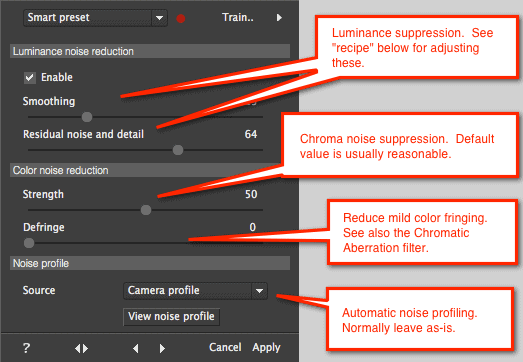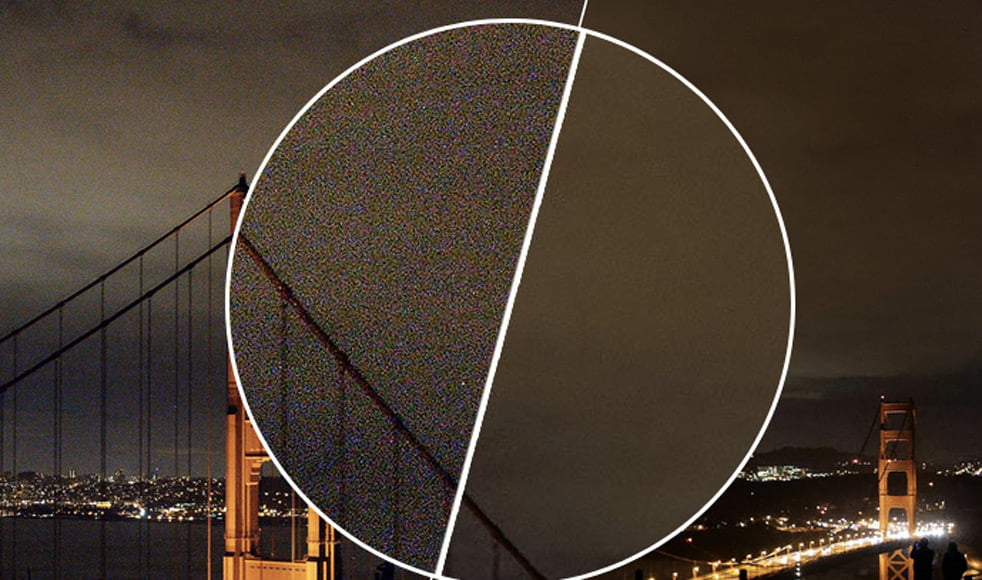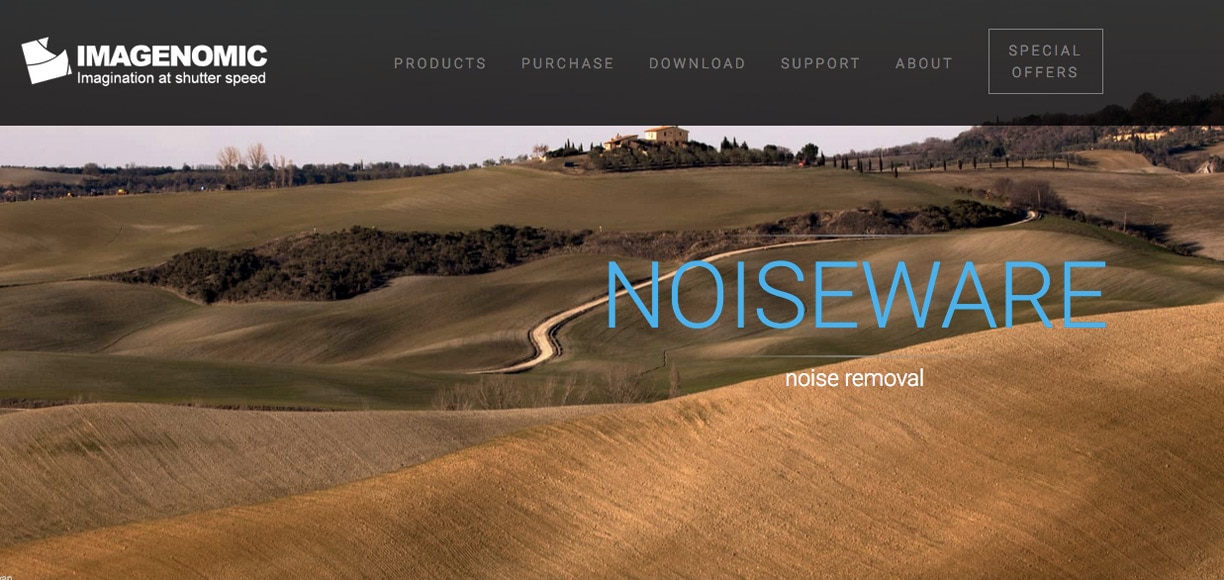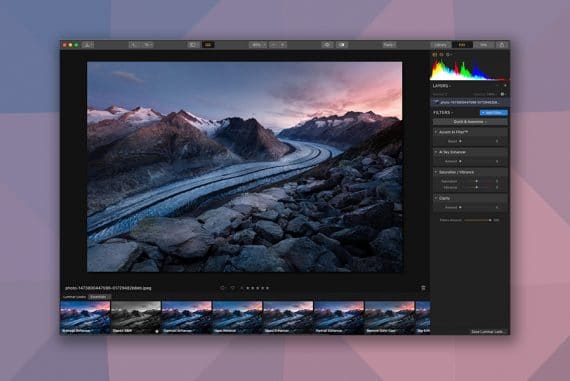
Best Noise Reduction Software to Clean up Grainy Photos
Need to reduce photo noise? This guide takes you through the best noise reduction software options in 2023 and how to choose. Read on!
Software | By Usnea Lebendig
Almost every photographer ends up needing to reduce image noise at some point, especially if they tend to shoot in low light situations or in HDR.
If this is you, then finding the noise reduction software that works best for you can be a real game-changer, and also invaluable for photo restoration too.
The problem is that there are so many different types of noise reduction software out there, it can be hard to decide which one to choose. Each has a different method and/or algorithm for noise removal and thus gets slightly different results.

Invaluable tool to remove noise and extract lost details from previously unrecoverable images.
On top of that, they all have their pros and cons. Some are more effective at preserving detail, some better at luminance noise reduction; some are easier to use, some far more expensive.
And while most work as a standalone program as well as a plugin, some only work when used with Lightroom or Photoshop.
What’s the best noise reduction software for you? That will depend on a number of different factors, not least of which is your budget, workflow, and the post processing software you’re already using.
But before we get into the different noise reduction applications, let’s take look at what image noise is and how noise reduction software works.
Table of Contents
Best Noise Reduction Software in 2023
| Image | Product | Features | |
|---|---|---|---|
 | Topaz Labs Denoise AIOUR #1 CHOICE |
| View Price → |
 | PictureCode's Noise NinjaTOP RATED |
| View Price → |
 | DxO's PRIME DenoiseGREAT VALUE |
| View Price → |
 | Imagenomic Noiseware |
| View Price → |
| Adobe Lightroom |
| View Price → |
1. Topaz Labs Denoise AI | Best All Round Solution
Currently, the best noise reduction software on the market is Topaz Denoise AI.
Topaz Denoise AI uses artificial intelligence to analyze a photo and then uses this information to selectively reduce noise while enhancing the details that already exist in your image.
While other noise reduction software tends to only look at pixel-level detail, the AI in Topaz Denoise actually “sees” the difference between detail and noise in your photos.
How? By feeding an algorithm millions of images until the software learned what noise actually is – both chroma and luminance – and how to remove it.
In terms of detail conservation, Topaz Denoise AI is currently the best program on this list. In terms of luminance noise reduction, it’s tied with Luminar.
It also has the most custom controls out of all the noise reduction software reviewed here. (One of the benefits to being software designed solely for reducing digital noise.)
Beyond adjustments for both luminance and color noise, you can also manually control shadow tone restoration, de-banding, and color casts.
The “reduce lens blur” adjustment is particularly amazing, especially when it comes to cleaning up noise in starry skies or images shot in low light. You can also adjust the opacity of your changes and/or add layers to refine the detail if it’s necessary.
You can also choose exactly where you apply noise reduction in your image, so you can smooth out some areas while leaving the texture as is in others.
If this seems overwhelming, don’t worry. Topaz Denoise AI comes in two modes – DeNoise AI and AI Clear.
If you just want the software to do its thing quickly without you having to do much, choose AI Clear. There are also a number of exceptional presets in Denoise. They make great starting places for beginners or those engaged with batch processing.
The batch processing features in Topaz Denoise AI are also formidable. You can either apply bulk settings to the entire batch or single out some of them for unique settings before processing all of them together.
Topaz Denoise AI works as a standalone program for Mac and Windows and as a fully supported noise reduction plugin with Adobe Lightroom and Adobe Photoshop. It works as a partially supported plugin with Luminar, ON1 Photo Raw, Capture One, Serif Affinity, and Corel PaintShop Pro.
If you do a lot of high-ISO shooting, the US$80 price tag will be well worth it. If that seems steep you can wait for it to go on sale – right now it’s just under US$60.
You can also buy it as a bundle with Gigapixel AI, Sharpen AI, and Jpeg to Raw AI.
2. PictureCode Noise Ninja

If you shoot commercial photography, PictureCode’s Noise Ninja has long been the gold standard for digital noise reduction in the high-end commercial world. Everyone from camera manufacturers to medical imaging companies would make use of it.
It got a bit neglected over the years, though, with fewer and fewer updates coming out. Now, though, Picture Code has finally come out with a new and improved version of Noise Ninja and has integrated it into its superb Raw converter – Photo Ninja.
If you’re here looking for the best noise reduction software, chances are you already have a program that does Raw conversion. If this is you, Photo Ninja works both as a standalone and as a plugin for Lightroom, Photoshop, and Photo Mechanic.
If, however, you’re looking for fantastic Raw conversion, Photo Ninja is said to be much better than Lightroom and some say it’s even better than Capture One and DxO Photolab.
But back to noise reduction: this newer version of Noise Ninja can often make up to a two-stop improvement in your photo’s image quality. Its luminance noise reduction works together with its sharpening feature so that you can enhance edges without increasing noise.
How Noise Ninja works with color has also been improved in the current version as well, and it’s even better at smoothing contoured areas.
Noise Ninja comes with a number of advanced features you can’t find in other noise reduction software. There’s a calibration chart that helps you to create noise profiles at each ISO setting (if you don’t have a camera profile for your image).
Noise Ninja also creates a precise noise profile (by frequency and color) for each area of the image you’re working with.
Something else that’s cool is that the noise reduction filter in Noise Ninja is trainable. It will read your ISO and camera model information from the EXIF files and then learn to set the sliders right where you want them.
With all the advanced features, Noise Ninja is extremely beginner-friendly. It’s quick and easy to use, with plenty of one-click options for beginners.
The user interface has been redesigned and they’ve renamed their sliders to better illustrate what they do. The luminance controls, for example, are now called Detail and Contrast.
From there you can find sliders that affect your Smoothing, Residual Noise, and Detail For color noise reduction they offer sliders for Strength and Defringe.

The price is pretty high – US$129 for a lifelong purchase and free upgrades for a year – but you get a lot with it. Photo Ninja itself is probably worth it alone for its pro-level noise reduction, but its other pro features make it a worthy investment.
Photo Ninja can be downloaded for free (without render and save functions) or you can ask for a 2-week fully functional free trial from their support desk.
3. DxO’s PRIME Denoise

DxO PRIME is another long-time favorite of photographers looking for the best possible noise reduction. Its ability to reduce noise while retaining detail you were probably sure was lost seems just short of uncanny.
PRIME stands for Probabilistic Raw Image Enhancement and honestly delivers best-in-class noise reduction. Most noise correction software works by comparing nearby pixels. PRIME, on the other hand, assesses a much, much larger area.
As a result, it’s not fast – but boy does it get fantastic results!
Like Noise Ninja, DxO PRIME uses camera profiles to accurately assess and correct noise without a lot of manual adjustment. The results tend to be amazing right out of the gun, but if you’re not completely satisfied with PRIME’s initial results, you can fine-tune everything with added controls.
There’s even a dead pixel correction slider which effortlessly removes hot pixels. See more of this in our full DXO Photolab review.
The “not fast” part, though, can be a deal-breaker for some. When you use PRIME’s noise reduction, you won’t be able to see its effect on more than just a small area until you export the entire image. The clincher? Image exports can sometimes take an entire minute.
If you have a lot of images to process and/or limited time, this probably isn’t the software for you. If you want exquisite results and the slow processing doesn’t both you, give it a whirl.
DxO PRIME comes as part of DxO’s Photolab Elite, which at US$199 is no cheaper than PRIME is fast. Still, if you want fantastic results, DxO’s PRIME Denoise (and PhotoLab in general) can deliver results you just can’t get with other photo editing software, especially in the areas of noise control and overall detail rendition.
This particular noise reduction software comes as both a plugin and standalone version.
4. Imagenomic Noiseware

Noiseware is another fantastic noise removal program.
Like Topaz Denoise, Noiseware uses AI to analyze the noise patterns in an image. As a result, it doesn’t have to rely on camera profiles. It learns as it goes, remembering the results of its image analysis and the image EXIF data that went with it.
It’s ridiculously easy to use, with a number of single-click presets that usually work well enough without any further adjustments.
If you want to fine-tune things, no worries. Noiseware’s Manual Profiling option lets you specify regions in an image and then customize the noise removal settings based on tone, color, and frequency. You can also selectively protect details and/or colors.
Noiseware is a plugin for Photoshop and works well with Smart Filters and Photoshop Actions. It also works with any image format that’s compatible with Photoshop. Cost-wise it’s competitive at just under US$80.
There are many who consider Noiseware to be the best noise reduction software on the market, with a few tales of having switched from Noise Ninja to Noiseware. Unfortunately, there doesn’t seem to be a free trial at this time, so be sure it’s what you want before purchasing.
5. Adobe Lightroom

As far as overall editing software goes, Adobe Lightroom is still the industry standard. While Lightroom noise reduction tools may not be up to Topaz AI’s or Noise Ninja’s abilities, it’s still more than adequate for what most photographers need.
The luminance and chromatic noise reduction sliders are pretty straightforward and come with more detailed adjustments. You can adjust the Detail and Contrast in the luminance noise reduction area. Under color noise, you can adjust the Detail and Smoothness.
One of the many things that makes Lightroom fantastic is its ability to do local, targeted adjustments. This is true for noise reduction as well.
You can use Lightroom’s Radial Filter, Gradient Filter and especially the Adjustment Brush to make targeted adjustments

After you’ve removed the amount of noise that seems best, Lightroom’s sharpening tool has a masking slider that will help you restore detail without introducing the noise back in.
So while Lightroom isn’t necessarily the best noise reduction software out there, it’s more than adequate for the general user.
What’s more, if you already have the Adobe’s Photography Plan, you can send things to Photoshop when you need more control.
If you don’t already have Adobe Lightroom, you can get it by subscription, either as part of Adobe’s Photography Plan or together with all of Adobe’s Creative Cloud Apps. The Photography Plan is US$9.99 month-to-month or just under US$120 paid each year (go here for up-to-date pricing).
6. Adobe Photoshop (Camera RAW)

Unsurprisingly, Adobe Photoshop also lands itself on the list of best noise reduction software options. It has excellent noise reduction abilities via its Camera Raw app.
Camera Raw uses the same algorithm as Adobe Lightroom, but being part of Photoshop ultimately gives you far more control over selective adjustments.
This is because of Photoshop’s masking abilities. There’s really no editing software that can come close to Photoshop’s selection and masking tools, and that makes it possible to do extremely specific and detailed adjustments.
For example, you can make color noise adjustments that don’t desaturate the entire image, or bring back tiny details that got smoothed out in your luminance noise adjustments.
Furthermore, Photoshop also has a number of advanced noise reduction controls, including a high pass filter, and so much more.

Of course, as with many things Photoshop-related, the learning curve is quite a bit higher here – especially when using the advanced channel-by-channel adjustments and/or blending and stacking layers.
Still, if you want supreme control, Photoshop is where it’s at.
Like Lightroom, you can get Photoshop as part of Adobe’s Photography Plan here or together will all of Adobe’s Creative Cloud Apps. The Photography Plan is US$9.99 month-to-month or just under US$120 paid each year.
7. Skylum Luminar

At the other end of the learning curve comes Skylum’s Luminar 4 (reviewed here), designed to streamline the photo editing process and as such, comes with a number of quick, powerful adjustments.
Its Denoise filter is no exception and is superbly easy to use, yet very powerful. That’s why many consider Luminar to be one of the best noise reduction software programs on the market.
The current version of Luminar – version 4 – brings with it a much improved Denoise filter performance. It also comes with all the standard controls you’d expect in noise reduction software: sliders for reducing luminance and chromatic noise, a boost slider for increasing the overall effect, and the ability to adjust the opacity.
In fact, many prefer Luminar 4’s noise reduction to other more expensive options, especially since it excels at luminance noise reduction, tied in first place with Topaz Denoise.
It also helps that Luminar comes with layer and masking abilities, making selective adjustments quite easy.
While its selection tools aren’t as sophisticated as Photoshop’s, one advantage Luminar 4 has is that you get the layer functionality of Photoshop with the non-destructive editing of Lightroom. You never have to worry about destroying the original image.

The thing to watch out for with Luminar, though, is that the Denoise filter is quite heavy-handed. It’s best to keep it on the low side.
Luminar comes as both a full standalone photo editing program and as a plugin for Lightroom and Photoshop. It generally retails for around US$70. No subscription is necessary.
There’s also the option of Luminar AI (reviewed here), which features some incredible artificial intelligence tools but doesn’t offer any DAM or file management features.
If you’re looking to reduce noise quickly and easily without a lot of fuss, Luminar 4 is a great option, especially if you’re looking for a low-cost alternative to Lightroom in general.
Noise Reduction Software: What to Keep in Mind
When it comes to reducing noise in your photos, there are always two main goals: to reduce digital noise and preserve image detail.
These often work against each other, since generally speaking, the more you reduce the noise in an image the more you lose detail. The converse is also true: the more you try to preserve detail, the harder it will be to effectively remove noise.
The trick is to learn how to find the best balance – how to reduce noise while preserving as much detail as possible.
Practically speaking, it’s important to know what kind of digital noise you’re trying to remove, which will in turn guide you in how to choose which is the best noise reduction software for you as well as in how to use it.
Types of Image Noise
There are two types of digital image noise: chromatic noise and luminance noise. Each gets removed in a different way.
- Luminance noise is the most common and is directly related to how much light is available.
It’s colorless and will often look like grain or sand. You’ll find it most often in underexposed images, high-ISO images, or as a result of the heat generated from long exposure photography which then creates “hot pixels”.
The way noise reduction software usually deals with luminance noise is by “smoothing” it, either with a manual luminance slider or automatically. This smoothing causes a loss of detail and sharpness.
In fact, all realistic images need at least some amount of luminance noise, as eliminating lit completely will usually result in an unnatural or plastic-looking image.
Finding a balance between getting rid of luminance noise and maximizing a photo’s detail is perhaps the biggest factor in choosing the best noise reduction software.
- Chromatic noise or color noise appears as uneven color transitions in an image.
You’ll see it more often in regions that are either very dark or very bright. It usually shows up as colored pixels that simply don’t match what’s around them.
This kind of noise tends to look much more unnatural and, if not kept under control, can make images unusable.
Noise reduction software tends to deal with chromatic noise by desaturating it a little at a time. Done too much or non-selectively, this can affect the saturation of the entire image.
If your images tend to have color noise, being able to selectively choose which areas to desaturate will be a factor you’ll want to keep in mind.
Final Words
While there’s a lot that can be done in post-processing to reduce noise, it goes without saying that the best option is to try to get the image as good as you can in-camera.
While noise reduction tools can help – they can’t really “fix” a bad photo. The best they can do is improve it.
When you get down to the nitty-gritty, there’s really no one program that wins the title of single best noise reduction software. Each program has its strengths and weaknesses, each does some things better than others.
For example, some excel at luminance noise reduction (Topaz and Luminar). Others, like Adobe Lightroom, offer easy, simple-to-use controls.
If you already have Adobe’s Photography plan or are already using Luminar, you’ve already got great noise reduction options. Of course, programs such as DxO’s Photolab Elite offer much more than Noise Reduction and might be worth trying out in their own right.
In the end, the best noise reduction software for you will come down to a number of different factors including, of course, budget, as well as what type of photography you do and how a program fits into your workflow.

Invaluable tool to remove noise and extract lost details from previously unrecoverable images.













